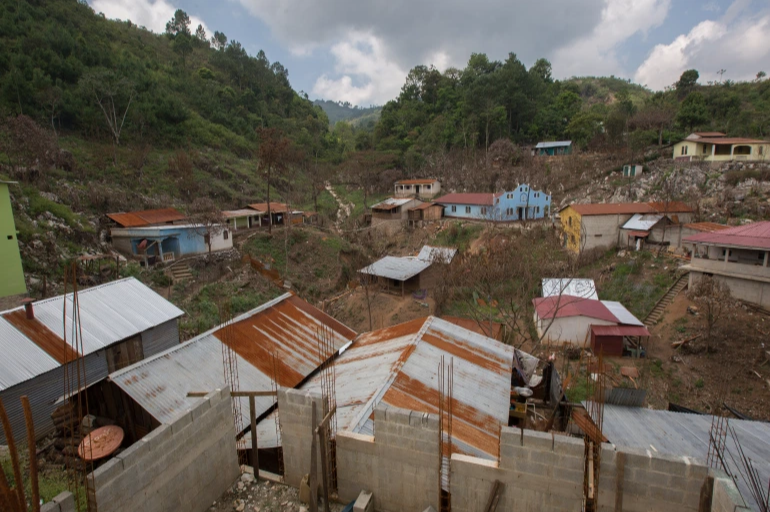
Devastating storms and flooding decimated the Guatemalan village of Campur, but some residents have since returned to try to rebuild [Jeff Abbott/Al Jazeera]
Guatemala City, April 18 (RHC)-- The water from the late November storms had not yet begun to subside in the rural village of Campur when Michelle’s husband, Byron, decided to leave for the United States.
Nestled in a lush valley in the San Pedro Carcha municipality, in northern Guatemala nearly 170 miles (270 kilometres) from Guatemala City, Campur’s streets were flooded by heavy rains brought by Hurricane Eta. At its peak, the water reached 12 metres in some places, submerging houses, possessions, animals and crops, and leaving only the church steeple above the waterline.
Michelle and Byron – who did not want their real names used due to concerns it could affect Byron’s immigration status in the United States – and their three children were among the nearly 600 families in Campur that lost everything.
“No one thought the water would recede, we did not have hope,” the 27-year-old mother told Al Jazeera as she tended to the family’s store, about her husband’s departure in November, shortly after the town flooded. But when the waters pulled back in late January, they revealed even more devastation – crops, homes and livelihoods were decimated – and the Guatemalan government’s promise to provide money for reconstruction and aid to families affected by the storms never materialised.
“The people were confident that the Guatemalan government would give support,” Erick Cu, a resident of Campur who works for the municipality of San Pedro Carcha, told Al Jazeera. “But we are entering an economic crisis, and the people have begun to migrate.”
Thousands of asylum seekers from Central America and Mexico – including families and young children – have arrived at the U.S.’s southern border in recent months in search of protection, heaping pressure on President Joe Biden to address what some have described as a humanitarian crisis. But to fully understand what is going on, experts say observers must examine the reasons pushing people to make hazardous journeys north.
While there are no exact figures on how many Campur residents have left for the US so far this year, Cu said he knows of at least 20 people who have gone since November. Sebastian Chub, a community leader, estimates between 50 and 60 people have left, and Al Jazeera spoke to a family who said seven members between the ages of 14 and 17 had migrated in the last few weeks.
The effects of the storms on Campur go beyond flooding. The local economy, which relies on the production and sale of coffee and cardamom, also was decimated. Combined with the COVID-19 pandemic, the storms exacerbated longstanding problems fuelling emigration, such as unemployment, poverty and food insecurity.
“The effects of the pandemic and the hurricanes have worsened the socioeconomic conditions,” Ursula Roldan, an immigration expert at Guatemala’s Rafael Landivar University, told Al Jazeera. “There is also an expectation that with the new Biden administration that migrants will manage to more easily enter the United States, that they will have an opportunity to go in family units.”
Among those who saw hope in the change of government in the US was Walter Choc. He set out from Campur for the US in February, but U.S. Customs and Border Protection (CBP) agents sent him back to Mexico in early March under Title 42, a Trump-era policy that summarily bars most migrants from entering the country due to the pandemic.
More than 172,000 people were taken into custody at the US-Mexico border in March, according to CBP data, and at least 103,000 were deported under Title 42. After two months of repeatedly trying to enter the US, Choc and his cousin decided to return to Guatemala.
“Our crops were under water, and we were unable to work to earn money for our families, and now we are in debt,” the 31-year-old told Al Jazeera from his father-in-law’s house in Campur. “We suffered a lot,” he said. “We decided to risk our lives trying to migrate to the United States because our authorities are not responding to our needs.”
Guatemalan President Alejandro Giammattei has made few comments on the situation in Campur specifically. Following the disaster, Giammattei said funds would be made available for the reconstruction or relocation of the village, but according to Cu, there have been no advances on the plan. The mayor of San Pedro Carcha, Winter Coc Bac, also accused the president of abandoning the region.
According to Guatemalan national daily Prensa Libre, as of January, the Guatemalan state has only used 25 percent (around $11m) of the $45 million made available to respond to the disaster. The ministry of communication, infrastructure and housing did not respond to Al Jazeera’s request for comment in time for publication.
Historically, only a few residents of the Q’eqchi Mayan communities of the northern department of Alta Verapaz, where Campur is located, migrated to the United States. But that changed over the last five years, as the region has been hit hard by soaring poverty rates. “There are entire villages that are going to the United States,” Cu, the local resident, told Al Jazeera.
Just over 83 percent of Alta Verapaz’s 1.2 million residents lived in poverty, according to the most recent National Institute of Statistics data from 2014, while at least half of all families suffered from extreme poverty. Cu also said a lack of access to arable land – which historically served as both a source of food and much-needed livelihoods – has contributed to the rise in emigration.

